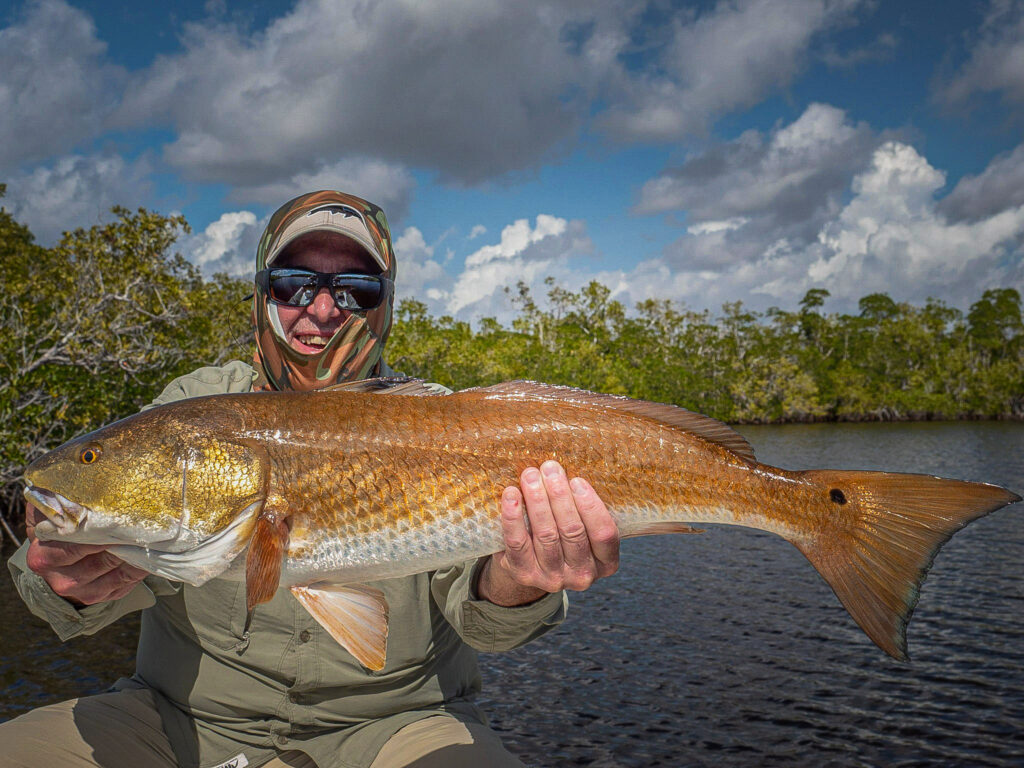Email Cell -305.393.1245
HOME » Redfish

Redfish are among the most rewarding and dependable gamefish in the Everglades including Florida Bay and Whitewater Bay. Alongside snook and tarpon, redfish are a cornerstone of the Everglades fishery. Most of the redfish we encounter here range from 3 to 8 pounds, which is a great size for light tackle and fly fishing. Now and then, we’ll hook into some bigger ones pushing past 15 pounds.
Of course, we don’t see the kind of record-breaking giants like the IGFA world record redfish, a 94-pound monster caught by off Hatteras, NC, or the beasts off the coast of Louisiana, but what we do have is a consistent fishery. Whether you’re a first-timer or a seasoned angler looking to sharpen your skills, redfish are always a great target. They’re resilient and adaptable, and provide plenty of excitement every time you hook into one.
What makes redfish so special in the Everglades is their versatility. We find them in just about every type of habitat the park has to offer. Large schools can gather in estuarine creeks and bays, especially during spawning season, while individual fish might cruise the open basins or shallow flats. For me, one of the highlights of guiding is sight-fishing for tailing reds in the shallow water.
The Everglades makes redfishing more than just a catch, it’s an experience. The flats, banks, bights, islands, creeks, and mainland shorelines of Florida Bay provide both a great setting and plenty of opportunity.
For targeting redfish, an 8 to 9-weight fly outfit paired with floating or clear floating fly lines is ideal. This setup provides the necessary balance of power and finesse to handle redfish in shallow water while also being versatile enough for other species that might be around.
A 9 to 11-foot tapered leader ending in 15-pound test fluorocarbon is a solid choice for redfish. However, because snook and small tarpon often share the same habitat, it’s wise to use a leader system that includes a bite tippet for added abrasion resistance. This small adjustment ensures you’re prepared for an unexpected snook or tarpon encounter without compromising your chances with redfish.
Since redfish are commonly found in shallow and sometimes weedy environments, weedless fly patterns can be essential. A well-designed weed guard allows flies to be worked effectively over obstacles such as logs and mangrove roots. While some argue that weed guards can reduce hookups, in my experience, the benefits far outweigh the drawbacks in certain conditions. The key is to use a light, well-tied weed guard only when necessary.
Redfish are opportunistic feeders and will take a wide range of flies, including:
For spin and plug fishing, a six to seven-foot fast-action rod paired with a quality reel is the go-to setup. Spool it with 10-pound test monofilament or #2 to #4 diameter braid (12 to 15-pound test) for optimal performance.
If snook or tarpon are around in the area, upgrading to a 30 to 40-pound test fluorocarbon leader is a smart move to prevent break-offs.
By choosing the right gear and making small adjustments based on conditions, you’ll maximize your chances of success when targeting redfish and other inshore gamefish in the Keys or Glades.
Everglades National Park began collecting entrance fees for all park visitors on January 10, 2019 – including anglers with licensed fishing guides, Effective January 2025, 7-day passes will be $35 per person. You may also purchase an annual Everglades National Park pass for $70. Children aged 15 and under are always admitted free.